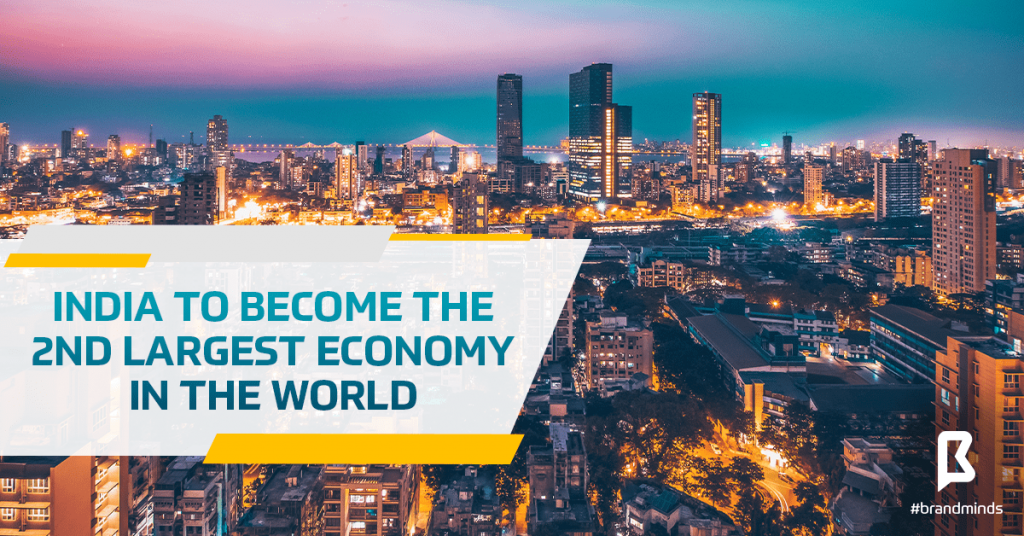The economists predict that by 2030, India will become the world’s second largest economy in the world. This article delves further into the subject.
According to the World Economic Forum, there is an important change taking place among the largest economies in the world:
- China is set to overtake the US as the largest economy by 2020 thus becoming the world’s most powerful economy in the world;
- India is likely to become the world’s second-largest economy by 2030;
- Crowned as the most powerful economy in the world since the 1800s, the US will lose its title within a year and step back to number 3.

image source: weforum.org
Here are 8 reasons this prediction is likely to come true:
1. Growth acceleration
India’s trend growth is accelerating to 7.8% by the 2020s partly due to ongoing reforms, including the introduction of a national goods and services tax (GST) and the Indian Bankruptcy Code (IBC).

In comparison, China is expected to grow at 6.6% in 2018 and 6.2% in 2019.
2. The world’s largest group of young people
While in the rest of the world, the ageing population is growing, India has become home to the world’s largest group of young people: half of the country’s population is under the age of 25, that is 600 million people.

3. The highest concentration of the urban population by 2020
The UN expects the world’s urban population to increase from 55% to 68% by 2050. This increase is expected to be highly concentrated in just three countries: India, China and Nigeria. India’s contribution is the highest: 416 million urban dwellers by 2050. In 2018 the urban population of the world accounted for 4.2 billion people.

4. $1 trillion real-estate market size by 2030
India is the country where the largest urban transformation of the 21st century is happening.
Key contributors to this growth are the Indian real estate and infrastructure, a young demographic base, growing income levels, expanding middle-class and stable democracy.

5. The fastest-growing cities
Rapid urbanisation is one of the five megatrends identified by PwC to shape the world in 2019. According to PwC, cities are breeding grounds for wealth creation and economic growth.

Indian cities are leading the change. Here is how:
- 70% of future employment is expected to be generated in Indian cities;
- Emerging cities (population less than 1 million) are driving consumption expenditure;
- Significant opportunities for domestic and international investments.
According to research institute Oxford Economics, all the top 10 fastest-growing cities by GDP between 2019 and 2035 will be in India: Surat, Agra, Bengaluru, Hyderabad, Nagpur, Tiruppur, Rajkot, Tiruchirappalli, Chennai and Vijayawada.
6. The 3rd largest consumer economy by 2025
According to the Boston Consulting Group consumer report, India will become the world’s third largest consumer economy by 2025 with consumption set to triple to $4 trillion.

The factors driving this growth are as follows:
- The wealthy will represent 40% of all spending, the largest consumer segment;
- Emerging cities will constitute ⅓ rd. of total consumer spending;
- Nuclear families will make three-fourths of all Indian households;
- Retail sales will increase from 30% to 35% due to digital channels;
- Online will grow to 10% from 8% as a preferred medium of retail spending.
7. The World’s Leader in renewable energy
According to the World Economic Forum, India will soon be leading the world in renewable energy.
India is currently in the second spot after Chile in the 2018 Climatescope report by energy researcher BloombergNEF. But the country’s latest increased investments, clean energy installations as well as the world’s largest renewables auction market have slingshot India in top three from the 5th position it held in 2017.

8. The Innovation Mission and the Innovation Diplomacy
The Indian Government has set innovation at the core of the country’s growth policies.
The country is currently running its innovation programme, the Atal Innovation Mission which started in 2016. The programme was designed to reach its goals by implemented the following: scaling start-up incubation centres, promoting innovation culture among schoolchildren by providing them with hands-on experience in 3D printing, leveraging the Internet of Things and developing robotics. As a result, India moved up in the Global Innovation Index, from 81st place in 2015 to 57th place in 2018.

Innovation Diplomacy was defined by the Mori Government as the ongoing diplomatic efforts in forging strong economic ties with other nations, based on innovation.
The efforts of the Indian diplomats paid off: the India-Israel Innovation Fund was launched in August 2018; the fund encompasses an annual investment of $4 million from each country for five years, putting its total value at $40 million.
Join the Conversation
We’d love to hear what you have to say.
Get in touch with us on Facebook Group and Twitter.



















